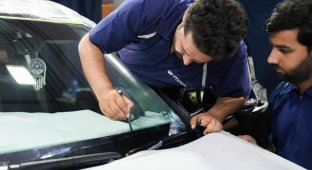Koreans continue experimental developments to maintain the temperature in the cabin (1 photo)
The Korean concern Hyundai-Kia presented new technologies that contribute to more efficient heating and cooling of the cabin. They reduce the energy consumption of the power plant, which is especially important for electric cars. 
The cooling nanofilm is glued to the glass. It prevents heat from penetrating from the outside and simultaneously removes it from the cabin. At the same time, it does not change the transparency of the windows. Therefore, unlike tinting, its use will be legal in any country.
The film consists of three layers. Two of them reflect solar energy, the third emits in the mid-infrared range of wavelengths. According to the developers, the film can lower the temperature inside the car by 12 degrees Celsius.
The "radiant heating" technology involves installing an additional infrared heater in the footwell. It works together with the traditional heater, but reduces the load on it by 17%. The elements heat up to 110 degrees Celsius, but special protection eliminates the risk of burns. Several such heaters can be installed in a car.
The third development was glass with a metallized coating. The latter is more effective for heating than traditional film. The description says that defrosting occurs four times faster and requires 10% less energy. In addition, the glass blocks at least 60% of UV radiation.
The presented solutions may appear on serial electric vehicles of the Hyundai-Kia concern in the near future. Before that, they will have to undergo a test cycle.






























